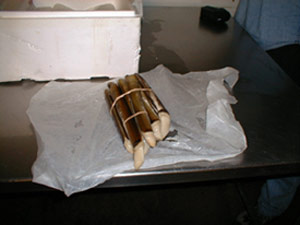| 2003 |

|
YEAR BOOK |
Bord Iascaigh Mhara
|
Can dredge caught razor clams
(Ensis spp.)
depurate successfully?
|

Razor clams with less than 230 colony forming units (CFUs) of E. coli per 100 grams of shellfish flesh are classified 'A' and may be marketed without being further treated. Razor clams with between 230 and 4,600 CFUs are classified 'B' and must be relayed, purified by depuration, or heat-treated by an approved process. In order to set depuration criteria, it is necessary to show that animals consistently depurate from class 'B' to Class 'A' within the standard 42 hour depuration period.
During 2000 and 2001, BIM, together with the Seafish Industry Authority (UK) and the Centre for Marine Resources and Mariculture (NI), carried out technical trials to evaluate the suitability of dredge caught razor clams harvested from 'B' category waters for depuration. It had been previously shown in the UK that diver caught razor clams did depurate successfully. If this proved true for the dredge caught razor clams too, then it could result in a diversification of fishing effort from the category 'A' waters into the category 'B' waters. This could lead to a reduction in fishing pressure on the 'A' clam beds. In addition, the depurated clams would now be suitable for the live market, thereby maximising the financial return to the fishermen when compared to the lower prices paid for razor clams destined for canning. Extensive trials were carried out in the Irish Sea using razor clams dredged by the fishing vessels, MFV Lady Lorraine, MFV Kelly and MFV Village Maid .
Three types of dredge were used throughout the trials. These are known in the industry as the 'Blade', 'Jet' and 'Italian' dredges respectively. The 'Jet' dredge is the most common used dredge in Ireland. It has no part that is inserted into the seabed. It relies on water being pumped from tubes suspended above the seabed that creates a small trench from which the target species are blown into the approaching cage. While the depuration results were inconsistent and favoured no dredge type, it was clear that the 'Jet' dredge is a much improved technology on the 'blade' dredge, and resulted in lower damage rates to the razor clams.
Razor clams are not able to fully seal their shell to prevent water loss in the same manner as oysters or mussels. Time out of water is therefore likely to be stressful to razor clams and result in rapid desiccation if the molluscs are not handled properly to minimise water loss. Therefore trials were carried out to investigate the length of time that the razor clams could be held out of water between harvesting and depuration. Results showed that being held out of water for up to eight hours appears to be acceptable and does not appear to cause sufficient stress to prevent razor clams from depurating. It should be noted that time out of water is based on animals held damp packed within cooler boxes, which helps to prevent desiccation. It is unlikely that animals held in an 'open air' environment would perform as well.
In common with other burrowing bivalves, razor clams rely partly on the pressure of the substrate surrounding their burrows to hold their shells closed. When dredged this pressure is removed with the result that over time the mantle splits and the razor clam begins to gape. In order to avoid this razor clams are usually 'banded' into 1kg bundles with two elastic bands or packed tightly into boxes (boxed). Both techniques provide sufficient external pressure to prevent gaping. The influence of these handling methods on depuration was assessed relative to loose razor clams held in a horizontal position. Animals from each handling regime were then held in water or dry onboard the fishing vessel. Investigations into these different holding techniques showed that holding the razor clams dry and out of water, without measures to prevent desiccation, resulted in those animals failing to depurate. Although the results showed that razor clams held loose did depurate, they experience a higher incidence of splitting, and therefore holding razor clams loose should be avoided. Overall around 25% of animals held loose split compared to between 4% and 14% of razor clams held banded or boxed.
In summary, the ability of razor clams to cleanse themselves of E. coli during depuration appears to be highly variable. The study indicated that, although razor clams did depurate, this was not achieved consistently. The reasons for this require further investigation, but may well be a result of stress involved by the dredge techniques used. It has been shown that it is possible to achieve consistent results with diver caught razor clams in the UK and, were a less stressful dredging technique to be developed, it may be possible to achieve similar results.
For more comprehensive details on these trials and/or for copies of a video and CD ROM entitled 'Razor Shellfish, Maintaining Quality Through Better Handling', contact Stuart McWilliams, BIM, P.O. Box 12, Crofton Road, Dun Laoghaire, Co. Dublin; Tel: 01-2144296.